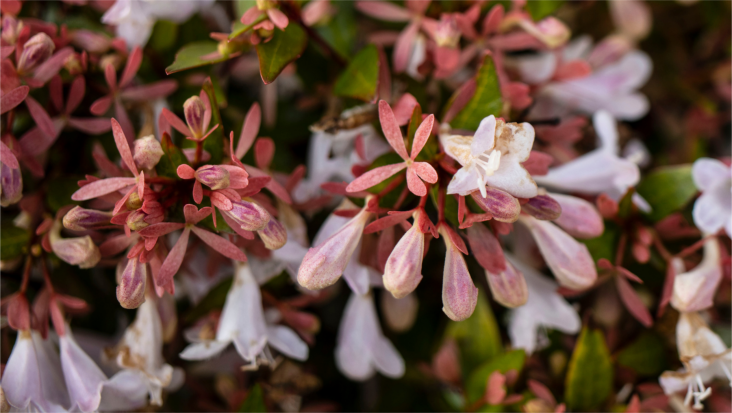What are Abelias?
Abelias are attractive, arching shrubs you’d love in your garden. Perfect as a hedge or a standalone pot, these 2 – 3 m tall beauties bloom with pink to white, bell-shaped flowers in summer and autumn. Here’s what you should know:
- Abelias come in numerous varieties, including variegated and dwarf.
- They take well to sunny or partially shaded spots with moist, humus-rich, well-drained soil.
- Regular pruning helps maintain its natural arching habit.
- They are hardy, but not fit for places with harsh winters.
- Fun fact: Abelias are resilient enough to survive next to a gas station, surrounded by asphalt, according to a horticulturist at the University of Georgia.
The Importance of Abelias in Australia
1. Abelias are native to Australia and are commonly found in the bushland.
Abelias in Australia hold vital importance, being native to the bushland area. This arching 2-3m shrub reveals itself abundantly in Australia’s landscape, enhancing its natural beauty. You can spot these plants punctuating the bushland with pink to white bell-shaped flowers from summer till autumn. Known for their attractive reddish new foliage, variegated and dwarf varieties of Abelias tend to flourish in the Aussie climate. Not only are they perfect for growing among other plants or trimming into hedges, but they also thrive in containers. A classic example of their prevalence is the Glossy Abelia (Abelia Grandiflora) widely grown in Australia. Take note though, Abelias prefer not to face severe winters!
2. Abelias provides an amazing amount of colour in the winter and spring months.
Imagine your Aussie winter garden glowing with shades of green, golden yellow, red, and orange. Your key to this winter bliss? Abelias. With their richly coloured variegated foliage, these shrubs light up your garden well into the spring months. Their amazing colour isn’t just eye candy, it’s also a mood lifter for those dreary winter days.
Moreover, Abelias play an integral part in your garden’s ecosystem, providing a habitat for birds, bees, and butterflies. Consider Abelia’s “kaleidoscope”, for instance, a pest-free variety that can reach about 90 cm tall and spreads 1.2 m wide. It’s known for its eye-catching and ever-changing foliage, making it a radiant, guilt-free favourite in many Australian gardens.
3. Abelias are easy to care for and are drought-tolerant plants.
Abelias are low-maintenance and drought-tolerant, making them perfect for Australian climates. Plant them in a spot with full or partial sun, in moist, well-drained soil for best results. New growth boosts their appearance with a reddish hue, turning glossy green over time. These plants bloom through summer showing off pinkish bell-shaped flowers that cover the shrub. Despite their hardiness (USDA 5-9), they might not thrive during severe winters. Pruning in late winter or spring will enhance their growth and keep them tidy. Be ready to spray for black spots in humid conditions and ward off blackflies with garlic plantings or a pyrethrum-based insecticide.
Remember, these delightfully fragrant plants can reach a height and width of about 1-2 meters.
4. Abelias can be used as privacy screens, foundation plants, and for ground cover.
Abelias are a versatile addition to Australian gardens, offering decorative and functional value. They are cherished for their stunning blooms and diverse uses, including privacy screens, foundation plants, and ground cover.
- Abelias serve as privacy screens with their dense, colourful foliage that grows to approximately 3 meters. Their ability to be trimmed regularly allows customization of your privacy levels.
- As foundation plants, Abelias provide an aesthetic base. Their wind, frost, and drought-resistant nature make them sturdy, low-maintenance additions to garden terrains.
- Abelias works as an effective ground cover. Their non-aggressive root system and hardy growth habit once established provide robust coverage to Australia’s diverse soil types.
5. Abelias can be propagated by seedlings, cutting, and dividing.
Abelias are attractive shrubs that can flawlessly turn any garden or landscape into an enviable art piece. There are several ways to propagate these plants. Let’s explore the three common methods: seedlings, cuttings, and division.
- Seedlings: Start by collecting seeds from mature Abelias during the fall. Plant these seeds in moist, humus-rich, well-drained soil and place them in a sunny location. Remember, Abelias prefers warmer climates.
- Cuttings: You can propagate Abelias from half-hardened or softwood cuttings. In late winter or early spring, cut a healthy branch that includes both flowers and leaves. Plant this cutting in a pot with well-draining soil.
- Division: For mature plants, division may be the easiest way to propagate. In this method, pull apart a portion of the plant at the roots and replant. This works best in early spring.
Each method will deliver results, however, cuttings are the most reliable way of preserving the parent plant’s traits.
6. Abelias can be interesting additions to a garden, patio, or yard.
Looking to add some charm to your Australian garden, patio, or yard? Abelias could be your new best friend. Here are some key features that make them popular with gardeners:
- Attractive, arching 2-3m shrub
- Blooms white to pink, bell-shaped flowers in summer and autumn
- Perfect for growing among other shrubs or hedging
- Thrives well in a container
- Exciting new and dwarf varieties are available
Now, let’s briefly weigh up the top 5 pros and cons of owning Abelias:
PROS:
- Hardy in temperate climates
- Gives new foliage a reddish hue
- Easy to prune and maintain
- Can grow in sun or part shade
- Furniture from cuttings
CONS:
- Not suitable for severe winters
- Requires well-drained, humus-rich soil
- Risk of becoming straggly without regular trimming
- Susceptible to black spots in humid conditions
- Attracts blackflies.
7. Abelias are known to attract hummingbirds and butterflies.
- Abelias, elegant arching shrubs blooming from summer to autumn, play a valuable role in Australian wildlife. Blooming white to pink bell-shaped flowers, Abelias attract local hummingbirds and butterflies.
- Specifically, the Abelia Grandiflora looms large, attracting native bees – Blue-banded, Teddy Bear, and Carpenter Bees.
- Your garden’s biodiversity could increase with Abelias. An increased number of hummingbirds and butterflies not only enhances aesthetic value but also contributes to pollination, vital for flora proliferation.
5 Stunning Varieties of Abelias in Australia
1. Abelia grandiflora
In the diverse and lush landscapes of Australia, the Abelia species finds its niche, especially the Abelia grandiflora. This particular variety, commonly known as the Glossy Abelia, boasts a rich display of tubular, fragrant flowers that vary in shades from pale pink to white. Set against a backdrop of glossy, semi-evergreen leaves, they make a sight to behold.
Their long-lasting bloom period and the delicate, cascading nature of their branches make them a favoured choice for flower arrangements and bouquets. Incorporating Abelia grandiflora into a floral design not only brings an elegant touch but also introduces a sense of the wild, Australian terrain into homes and events. With its resilient nature and unparalleled beauty, the Abelia grandiflora stands as a testament to Australia’s rich botanical heritage, making it a preferred choice for those looking to add a touch of the Australian wilderness to their arrangements.
2. Abelia Florida
Australia is home to a diverse range of flora, and among them, the Abelia varieties stand out prominently. Renowned for their graceful arching branches and profusion of small, tubular flowers, Abelias are especially cherished by gardeners down under. The Abelia ‘Florida’ is a particular favourite, with its lustrous green leaves, sometimes edged in delicate pink, and clusters of fragrant, bell-shaped flowers ranging in shades from white to pale pink. As the seasons change, the leaves often turn to a fiery shade of red, adding another layer of charm.
Given their inherent beauty and versatility, Abelias, especially the Florida variety, are often chosen by florists and garden enthusiasts for flower arrangements and bouquets. Their delicate flowers and long-lasting foliage lend an air of elegance and whimsy, making them an excellent choice for both contemporary and traditional floral designs. Whether displayed in a grand centrepiece or a simple posy, Abelia Florida undoubtedly adds a touch of Australian charm to any arrangement.
3. Abelia hybrid
Abelias, particularly the hybrid varieties, are renowned plants native to Australia that have won the hearts of many gardening enthusiasts. With a diverse range of species, Australian Abelias boast a tapestry of colours, shapes, and sizes, making them an ideal choice for flower arrangements and bouquets. The delicate tubular flowers, often in shades of pink, white or red, are accompanied by glossy green or variegated foliage that can add depth and contrast to any floral design. Their long-lasting blooms and attractive semi-evergreen to evergreen leaves remain a popular choice for ornamental gardens and cut flowers. Incorporating Abelia hybrids in bouquets can elevate the arrangement’s aesthetic appeal, giving it a touch of natural elegance and sophistication.
4. Abelia x grandiflora
Australia boasts a diverse range of Abelia species, with Abelia x grandiflora being one of the most notable. Known for its delightful, trumpet-shaped flowers that range from pale pink to pristine white, Abelia x grandiflora, also referred to as the glossy abelia, is a preferred choice among Australian gardeners and landscapers. Its arching branches drape gracefully, laden with clusters of fragrant blossoms that attract pollinators, especially during the summer months. The resplendent foliage that transitions from green to bronzed hues in the colder months further amplifies its charm.
Australian floral designers and enthusiasts have discovered that the dainty blossoms and intricate stems of the Abelia x grandiflora can make exquisite additions to flower arrangements and bouquets. The delicate aesthetics, combined with a subtle fragrance, render it a versatile choice for both contemporary and traditional floral designs. Whether showcased as a standalone centrepiece or combined with other native Australian blooms, Abelia x grandiflora never fails to add a touch of elegance and grace.
5. Abelia carinata
Abelias, particularly the Abelia carinata variety, are a distinctive and charming group of plants native to Australia. This particular species boasts a mesmerising range of colourful flowers that often shimmer in hues of pink, white, and occasionally soft lavender. Their delicate petals, paired with glossy and sometimes variegated leaves, make them a versatile and eye-catching choice for flower arrangements and bouquets.
When used in floral displays, the Abelia carinata adds a touch ofthe Australian wilderness and a hint of sophistication, making it a favourite among florists and decorators. Its subtle fragrance and resilience also mean that it not only beautifies spaces but also lasts longer, giving a persistent touch of nature’s elegance. Whether used as a focal point or a complementing filler, the Abelia carinata undoubtedly elevates the aesthetic appeal of any floral composition.
How to Care for Abelias in Australia?
1. Water Abelias regularly.
Watering is crucial for the well-being of Abelias; it supports their growth, flower production, and overall health. Follow these steps to water Abelias efficiently:
- Start by watering your plant thoroughly at the time of planting to establish the root system.
- For the first month, water the plant twice a week.
- During summers, water the plants well, especially if the soil is light to prevent drying up.
2. Avoid overwatering the plant
Overwatering can drown Abelias’ roots, making them weak and susceptible to diseases. Here’s how to avoid this problem:
- Start by choosing a pot with at least 300mm width and depth. This helps with apt drainage.
- Place your Abelia in a sunny or partly shaded position. It’s more forgiving to underwatering.
- Water your Abelia regularly until established. Then, cut back as they are drought-hardy.
- If you’ve used a slow-release general-purpose fertilizer, be careful not to overwater. Heavy watering can wash away the nutrients.
- When giving a trim in late winter to early spring, use this opportunity to check the soil’s moisture.
- Always monitor the plant for signs of overwatering like yellowing leaves.
3. Provide adequate drainage
Providing adequate drainage for your Abelias is crucial to prevent root rot and facilitate healthy growth. Here’s how you can ensure optimal drainage:
- Start with selecting a pot that is at least 300mm wide and deep.
- Opt for a sunny or partly shaded spot for your plant.
- Create a nurturing environment by adding Yates Dynamic Lifter Soil Improver & Plant Fertiliser to the planting area.
- Ensure you have quality potting mix, like Yates Potting Mix with Dynamic Lifter, to fill your chosen pots.
- Plant your Abelias and backfill gently with your potting mix.
- Schedule reapplication of Yates Dynamic Lifter Soil Improver & Plant Fertiliser every 8 weeks from spring until mid-autumn for good soil health.
4. Feed the plant regularly
Feeding your Abelias plants is crucial for their vibrant bloom and robust growth. Here’s how you can give them a healthy boost:
- Start with feeding them with Yates Thrive Roses & Flowers Liquid Plant Food during new leaf growth and flowering. Add it to their diet every week.
- Every 8 weeks, from spring to mid-autumn, introduce Yates Dynamic Lifter Soil Improver & Plant Fertiliser around the root zone. This crucial step enhances soil health.
- Consider using a slow-release general-purpose fertilizer during spring and summer for good results if your soil lacks nutrients.
5. Prune the plant periodically
- Begin by selecting the ideal time to prune your abelia – late winter or very early spring.
- Note that while pruning isn’t strictly required, it helps maintain a compact, neat appearance, especially after a harsh winter.
- When pruning, cut back any dead branches from winter damage.
- Don’t be afraid to prune aggressively; abelias bounce back well with new, compact growth.
- Avoid pruning during the growing season, as this can limit your flower output.
- Lastly, always do a single annual prune before the growing season starts; this keeps your abelia bush attractive and ensures it flowers well.
- For your ease, no conclusion is needed, just follow these steps and have a healthy abelia!
- Remember: indeed, pruning time is “tool time.” Happy gardening!
6. Weed the soil
- Choose a sunny or partly shaded spot for your Abelias. For best results, the area should be at least 300mm wide and deep.
- Prepare the soil well. Incorporate Yates Dynamic Lifter Soil Improver & Plant Fertiliser to enrich the soil.
- Dig a hole in the prepared area then place in your Abelia.
- Backfill around the root ball with soil, but be gentle.
- Water the plant thoroughly and apply an organic mulch like bark chips or pea straw.
- Remember to reapply Yates Dynamic Lifter every 8 weeks from spring until mid-autumn.
- Lastly, prune your Abelias in late winter/early spring for healthy growth. Enjoy your beautiful garden!
7. Plant in an appropriate spot
Choosing the right spot is vital for your Abelia to thrive in Australia. So grab your gardening gloves, and let’s get to it.
- Identify a sunny or partly shaded spot in your garden for optimal sun exposure.
- As you prepare your site, dig in some Yates Dynamic Lifter Soil Improver & Plant Fertiliser for an uber-healthy start.
- Look out for moist, well-drained loamy soil, although Abelias do tolerate sand and clay soils.
- Always remember to backfill around the root zone gently with soil and water in the well.
Tip: Once established, they’re quite drought-hardy and pest-resistant. Every 8 weeks, from spring to mid-autumn, give the soil around the root zone a Dynamic Lifter boost.
8. Know the variety of the plant
Knowing the variety of the Abelia plant is essential when caring for it in Australia. The Abelia, a semi-evergreen shrub from the Caprifoliaceae family, exhibits variations in aspects such as size, soil preferences, and drought tolerance. For instance, some varieties grow between 2′-3′, and others between 3′-6′. A difference in variety can also mean different sunlight exposure needs with options ranging from full sun to partial sun. Varieties may also have distinct flower colours, attractive to specific pollinators like bees, butterflies, and hummingbirds, and their maintenance varies. Hence, understanding the specific variety will ensure the right care for a thriving garden.
9. Provide adequate sunlight
Hey there! Abelias adores the sun! So, here’s a guide to get just the right amount:
- First, find a sunny or partly shaded spot in your Australian garden for your Abelia.
- If pot planting, get a pot that’s a minimum of 300mm wide and deep.
- Position it in a place that gets plenty of sunny rays or partial shade.
- Bear in mind, that Abelias are versatile. They can thrive in both full sun exposure and part shade.
- Here’s a pro tip: they’re drought-hardy once established so don’t worry about oversunny, dry days.
- Just remember, they don’t love hard freezes, so keep an eye out when the temperature drops!
And voila – you’re all set to bask your Abelias in the Australian sunshine!
10. Observe the plant for pests and diseases
Observing your Abelias in Australia for pests and diseases is vital for keeping them healthy. Here’s a brief guide to aid you in this process:
- Always choose a sunny or partly shaded spot in your garden to plant your Abelias.
- During the planting, include Yates Dynamic Lifter Soil Improver & Plant Fertiliser in the soil.
- Regularly water your Abelias until they’re well-established. After that, they become drought-hardy.
- Watch out for new leaf growth and flowering periods, and feed them with Yates Thrive Roses & Flowers Liquid Plant Food once a week during these times.
- Be aware that Abelia plants can tolerate drought, sun, and light frost, but struggle with hard freezes.
Regular observations protect your Abelias from potential diseases and keep them in tip-top shape.
Conclusion
Abelias, with their enchanting beauty and adaptability, undoubtedly deserves a prime spot in Australian gardens. Their presence not only enhances visual appeal but also champions the cause of biodiversity. With such incredible benefits and aesthetics, it’s an invitation to every gardener to experience the magic of these plants firsthand.
In conclusion, the rich diversity and captivating beauty of Abelias in Australia make them a choice addition to any garden or living space. Their resplendent blooms and versatile nature have made them a favourite amongst flower enthusiasts and novices alike. If you’re inspired by these gorgeous varieties and want to share their splendour with someone special—or simply treat yourself—don’t hesitate. Choose Bourkes Florist for the freshest and most exquisite Abelia arrangements. Click here to order your bouquet and have it delivered right to your doorstep. Let the beauty of Australia’s Abelias enchant your loved ones today!
FAQs
Q: How often should I water my Abelia plants?
Young plants require consistent watering, but mature Abelias are drought-resistant, needing water only during extended dry spells.
Q: Do Abelias attract wildlife to the garden?
Yes, especially pollinators like bees and butterflies are attracted to their fragrant blooms.
Q: Can Abelias be grown in pots or containers?
Certainly! Ensure the container has good drainage and use a well-draining potting mix.
Q: What companion plants work best with Abelias?
Native Australian plants, like Grevilleas and Banksias, pair wonderfully with Abelias.
Q: How quickly can I expect my Abelia to grow in Australia?
Growth rate varies by variety, but on average, with proper care, they can grow 30-60cm per year.






























